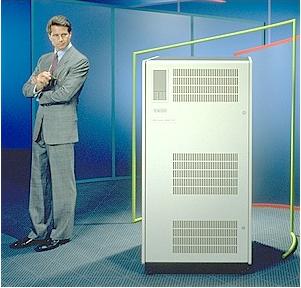 |
1990 |
| The KA640 CPU module was based on the CVAX+, and formed the heart of the MicroVAX 3300/3400, which were aimed at smaller offices (the correct term of the 1990's would be "workgroup server"). While a normal qbus system with 54 MBs of RAM atmost, a DSSI controller was included on the CPU module. There was also a version of the machine intended for real-time jobs, this series was called rtVAX, which had VAXELN as operating system. |
| The MicroVAX-line has grown
up, and now it's called VAX... While they still used the qbus, 4000's were
powerful enough. There were several models of the 4000-series, from which
the 4000-200 was the first (KA660, 64 MB RAM max, DSSI and ethernet on
the CPU module). Since the network and disk controllers were implemented
on the CPU module, the qbus was only used for further expansion, so
the machine was fast. The 4000-300 lifted the 64 MB memory limitation (bringing
it to 256 MB's), while the 4000-500 can handle memory up to 512 MB.
The VAXstation 4000 (105, 505, 705, 60) line is a different story, they resemble more of the 3100-series, than the qbus-based VAXen, but they are the strongest desktop VAXen. |
4000-200 with the front opened
4000-200 with expansion box
4000-500
Face to face
Family picture
4000 Model 108, rackmount
version
 |
Based on the Mariah chip (1 micrometer CMOS technology), the 6000-500 doubled the performance of the 6000 series (shorter cycle time, bigger write-back cache). The top model (6000-560) has a performance of 72 VUPs. |
| A series of fault-tolerant VAXen: multiple redundant processors, mirrored memory systems and disks, multiple cluster- and networking connections, everything done in hardware, so that any original VMS software can run unmodified! |
Misc
PDP11/93: The last PDP-11 built by Digital (although it was designed by a german company).

